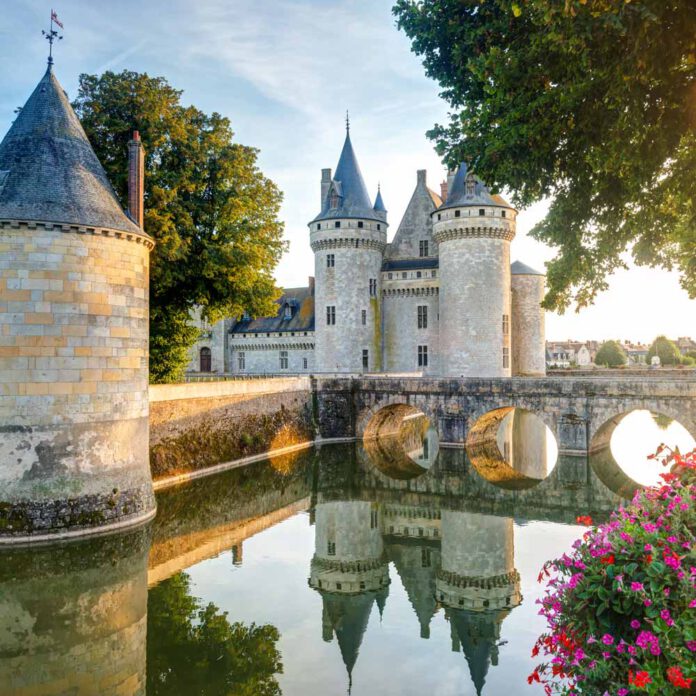From the 14th to the 16th century, the French kings resided on the banks of the Loire, where it was quieter than in “rebellious” Paris. At the beginning of the Renaissance, there was a preference in this region for stately residences that would forever shape history and the landscape. Journalist Philippe Bourget traveled the Loire Valley and was captivated by the magnificent, yet more discreet, castles.
One day, I decided to explore the castles along the Loire in the summer. A chance to refresh the history learned long ago in school, a complex narrative with so many important dates and eras. Who lived where and when? What were the artistic preferences of the kings? What dramas, love affairs, and intrigues unfolded there?
A journey to the Loire Valley is synonymous with a journey into the past, to a time when the kings shaped France. A journey to (re)understand history. So far, so good — but which castles should one have seen? In the Loire, there are over a thousand manors, country houses, and castles. In 2000, UNESCO designated the Loire Valley between Sully-sur-Loire and Chalonnes as a World Heritage Site. This spans 280 km from the east of Orléans to the west of Angers, characterized by an outstanding landscape, villages, and the most magnificent castles of the Loire. Let’s embark on a downstream exploration.
1. Sully-sur-Loire – the daring castle
The first stop on my route, and already a symbol of the end of the royal era in the Loire Valley. This fortress, with its medieval keep and slate-roofed towers, was once home to the Duke of Sully, finance minister to Henry IV, and was built at the confluence of the Sange and the Loire. The treasurer, who bought the château in 1602, worked for a king who had already returned to Paris. Henry III had still resided in Blois. The castle, where Joan of Arc and the future Louis XIV both stayed, boasts a magnificent great hall and a treasury room. In the park, I discover that Voltaire premiered two of his tragedies here.

2. Chambord – the majestic castle
This is the château of châteaux, the embodiment of royal pride and ambition, above all that of Francis I. A daring Renaissance creation unlike anything else, an immense stone colossus, even more extravagant than Versailles. The figures alone are dizzying: 426 rooms, 282 fireplaces, 77 staircases. As a young man, Francis I came hunting in the area, fell in love with the landscape, and in 1519 launched an incredible project. It took 40 years to build the castle and decorate its rooms, and even to divert a river (the Loire proved too unruly). The décor includes some 800 salamander motifs, the emblem of Francis I.

3. Blois – the castle of many eras
Blois is one of the most famous castles in the Loire Valley, combining architectural styles from four different periods. Each king of France left his mark through alterations and extensions. When Louis XII became king in 1498, he made Blois the capital of the kingdom. The medieval structure overlooking the Loire was transformed into a royal palace. Each wing represents a distinct era: two are attributed to Louis XII, one to Francis I (with its graceful loggia and Renaissance staircase), and one to Gaston of Orléans. A dark event sealed Blois’ fate. The assassination of the Duke of Guise by Henry III in 1588 was the eternal struggle for power.

4. Amboise – the artistic castle
Overlooking both the Loire and the town, Amboise was a royal residence from Charles VIII to Henry II, and again under Louis-Philippe. The palace moves me with its two remarkable façades, blending late Gothic and early Renaissance elements that recall Leonardo da Vinci, the Florentine genius who stayed here at Francis I’s invitation from 1516 to 1519. His presumed remains lie in the chapel. Yet in truth, I have seen only a fraction. A 1577 model shows that the château, partially destroyed in the 17th and 19th centuries, was once five times larger. On the esplanade stretching to the river, I think of Catherine de’ Medici, who brought Italian art de vivre to Amboise.

5. Chenonceau – the elegant castle
Arriving at Chenonceau, I can’t help thinking of the rivalry between Diane de Poitiers and Catherine de’ Medici. Spanning the River Cher (unique in the region!), Chenonceau is a woman’s castle, and its elegance proves it. The first lady, King Henry II’s mistress, designed the vast gardens and built a bridge over the river from the main residence. The second, Henry II’s wronged wife, took over Chenonceau after his death and sent Diane de Poitiers off to Chaumont-sur-Loire. She added the famous two-storey gallery atop the bridge, giving the château its matchless grace. My favourite in the Loire Valley!

6. Azay-le-Rideau – the enchanting one
Standing on an island in a branch of the River Indre, surrounded by water, Azay-le-Rideau naturally calls to mind Chenonceau. To me, the two are the loveliest Renaissance castles in the region. Its English-style park, where the castle’s reflection shimmers in the water, radiates extraordinary charm. I admire the splendid staircase in the courtyard with its double windows and loggias, the fine pilasters framing the windows, and the private rooms adorned with tapestries reminiscent of the Italian style of the time. Even the 19th-century embellishments have done nothing to diminish its original beauty.

